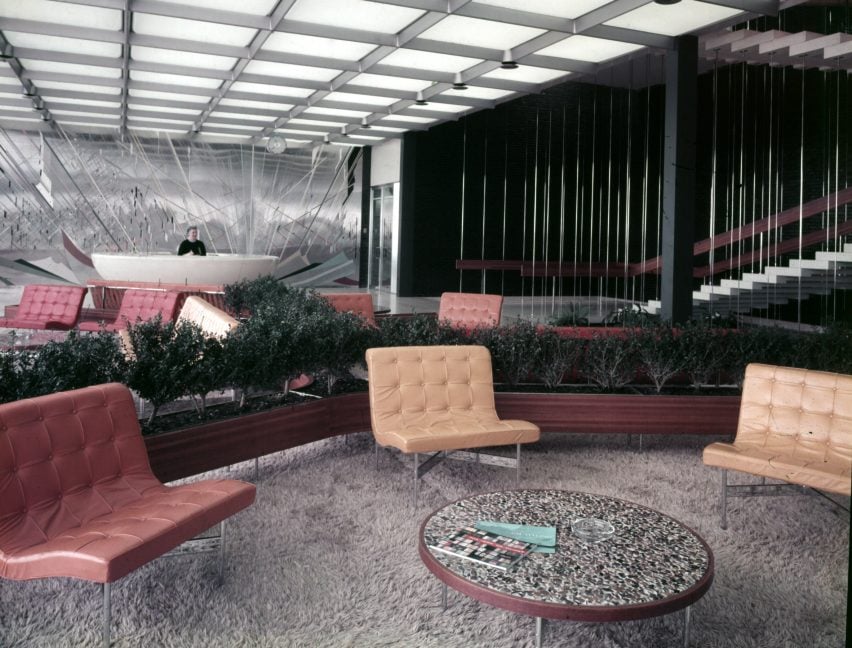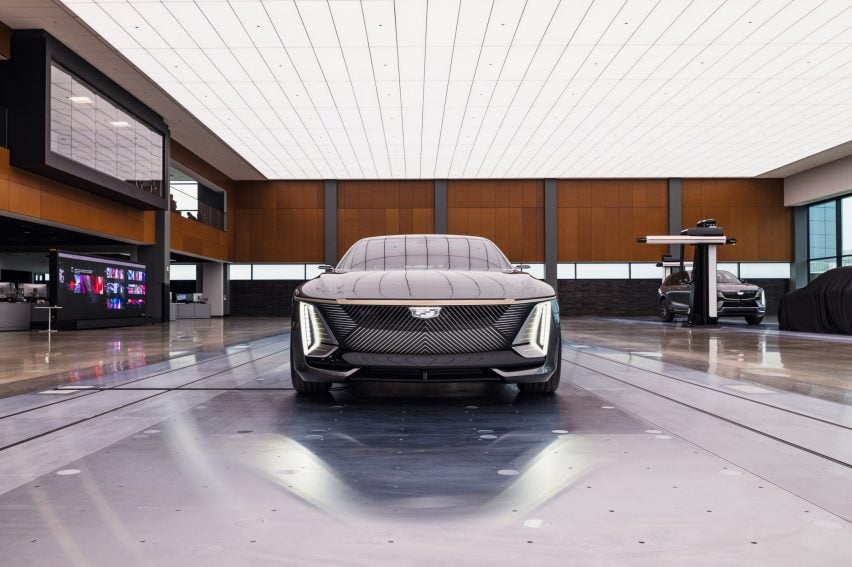The Warren Technical Center in Michigan, the first solo project by Finnish-American architect Eero Saarinen, showcased the unity of mid-century architecture, design and engineering in the United States.
Completed in 1956 in a small town outside of Detroit, the headquarters comprises a number of administrative, testing and design facilities for General Motors (GM).
Driven by GM head of design Harley Earl, the campus was meant to create an environment for innovation, with every aspect reflecting the company’s high standard of design.
“[Earl] created the first automotive design department that would be able to apply aesthetic considerations to a mass-produced, industrial product,” GM curator and archivist Natalie Morath told Dezeen.
This approach to design consideration continued with the Tech Center project and the architecture that would support the organization, from the large scale of the entire campus, down to the smallest detail – like the chairs that designers sat in – and was very much a shared priority of Eero Saarinen,” she added.
The centre was built in the context of the post-war economic boom in the country, which coincided with many European architects and mass-produced consumer items exploding in popularity.

Many of the more than 30 buildings designed by Saarinen were rendered in the International Style, with some aesthetic flourishes such as the silver-coloured Design Dome and Auditorium.
Saarinen was tasked by Earl to design the campus to reflect the future-looking ethos of the company at the time and to facilitate the industrial design and engineering taking place there.

“The campus needed to immediately communicate to visitors the significance of GM as an American company, and it needed to reinforce its vital role in the future,” said Morath.
“As incredibly practical as it may be, the campus also must function as a bit of a dream world, where designers and engineers are inspired to envision the future.”

The buildings themselves feature clean lines and industrial detailing on the outside, with colourful spaces and a mix of natural and industrial materials spread throughout the interiors.
Many have sculptural staircases at the centre that highlight the openness of the space.
Saarinen and Earl also collaborated with some of the leading names in mid-century furniture design at the time, such as the Eamses, Harry Bertoia, and Florence Knoll, modulating their popular designs to fit the needs of the campus.
Earl commissioned Danish designer Finn Juhl to design a chair for his personal office.
According to Morath, the campus functions more like a small town than a traditional business centre, with roads and other facilities for the staff.
Saarinen worked with American landscape architect Thomas Dolliver Church to carry out the vision, including plantings as well as reflecting pools.
“It was the type of project where one architect was providing a vision for a really large space, a holistic vision, where all the buildings and all the landscaping – everything would work together,” said Morath.

The scheme included the integration of large-scale works of art, such as a water fountain by American sculptor Alexander Calder, which was recently restored in line with efforts to revamp the historical aspects of the campus alongside new builds.
This integration of functional and artistic elements in aspects of the campus can also be seen in the futuristic, aluminium-clad water tower on the site.

The Tech Center was where many of the concept cars and experimentations in post-war automobile technology were designed for GM.
During this time, the design team at GM developed the first three futuristic Firebird concept cars, and the building was often used as a prop to underline GM’s focus on modern design.
Photoshoots were staged on campus, using the Eero Saarinen-designed buildings as backdrops, further driving home the message that the architecture of the campus was as future-oriented as the concept vehicles,” said Morath.
Since its construction, the campus has also undergone significant expansions, which, according to Morath, was part of the original brief.

“Eero Saarinen’s original design was a highly functional and highly specialized industrial campus that was intended to meet GM’s needs at the time, and accommodate its needs in the future, whatever those might be,” she said.
The campus showcased what it meant for mid-century design concepts, such as organic shapes and flexible design, to be applied at a massive scale.
It also incorporated the Bauhaus principles from earlier in the century, combining a future-looking vision with creating human-oriented spaces for work.
“The campus needed to be large, enclosed and private to protect GM’s confidential product development activities, and it needed to inspire its residents to focus on innovating for the future,” said Morath.
Saarinen would go on to design a number of other iconic structures in the United States that took on the industrial materials of the age.

The Warren Technical Center has since become an icon in the context of American mid-century architecture and design, integrating as it did Saarinen and Earl’s grand visions for an integrated industrial facility.
It has expanded over the years to accommodate the growing facilities, and Morath said that the new buildings are always designed with deference to the original scheme.
In 2014, it was designated as a National Historic Landmark in the United States.
The photography is courtesy of General Motors.

Mid-century modern
This article is part of Dezeen’s mid-century modern design series, which looks at the enduring presence of mid-century modern design, profiles its most iconic architects and designers, and explores how the style is developing in the 21st century.
This series was created in partnership with Made – a UK furniture retailer that aims to bring aspirational design at affordable prices, with a goal to make every home as original as the people inside it. Elevate the everyday with collections that are made to last, available to shop now at made.com.

